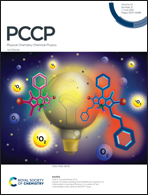Machine learning classification of disrotatory IRC and conrotatory non-IRC trajectory motion for cyclopropyl radical ring opening†
Abstract
Quasiclassical trajectory analysis is now a standard tool to analyze non-minimum energy pathway motion of organic reactions. However, due to the large amount of information associated with trajectories, quantitative analysis of the dynamic origin of reaction selectivity is complex. For the electrocyclic ring opening of cyclopropyl radical, more than 4000 trajectories were run showing that allyl radicals are formed through a mixture of disrotatory intrinsic reaction coordinate (IRC) motion as well as conrotatory non-IRC motion. Geometric, vibrational mode, and atomic velocity transition-state features from these trajectories were used for supervised machine learning analysis with classification algorithms. Accuracy >80% with a random forest model enabled quantitative and qualitative assessment of transition-state trajectory features controlling disrotatory IRC versus conrotatory non-IRC motion. This analysis revealed that there are two key vibrational modes where their directional combination provides prediction of IRC versus non-IRC motion.



 Please wait while we load your content...
Please wait while we load your content...